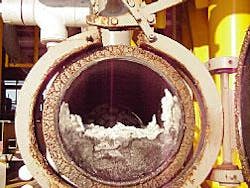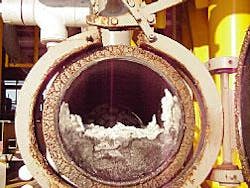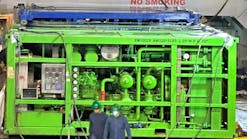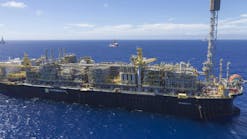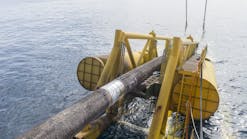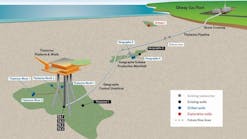William Furlow
Editor-in-Chief
Addressing the crystalline structure of hydrates opens up a variety of solutions to hydrate plugging in flowlines. Hydrates are ice-like crystals that form when the water in a production stream flowing from a well begins to freeze. If these crystals are allowed to progress, they can line the walls of the flowline with hydrates, restricting flow or, in extreme cases, blocking the flow and entirely forming a plug.
To avoid this problem, operators inject hydrate inhibitors such as methanol or glycol into the stream. Other options, such as insulating the flowlines from the extremely cold temperatures of deepwater, or active heating, are used on oil lines. For start-up and shut-in/restart, however, flow assurance chemicals are still required to prevent the lines from icing up while the oil isn't flowing. Injection of inhibitors is the most common solution to this problem, but it has several drawbacks. Because high volumes of these chemicals have to be injected into the well stream, there are storage and logistical issues. Facilities are often designed around the flow assurance plan. There is a trend by refineries to limit the amount of methanol they will accept from an export line.
LDHI
One option that could avoid a lot of the limitations of hydrate inhibitors is the use of low dosage hydrate inhibitors (LDHIs). There are two basic types of LDHIs - anti-agglomerates and kinetic inhibitors. Ajay Mehta, of Shell Global Solutions, says the premise for such chemicals came from the observation that certain fish do not freeze in the subzero temperatures of arctic waters. Investigating this, Mehta said, it was learned that a certain protein secreted by these fish bonds itself with microscopic ice crystals, preventing the crystals from connecting with each other and forming larger crystals.
Hydrate formation blocks flow lines and must be cleared by pigging.
Shell has used this technology to develop LDHIs that could inhibit the formation of hydrate crystals in well streams that flow through extreme conditions, 35° F.
The anti-agglomerate LDHI allows smaller crystals to form, Mehta said, but prevents them from bonding. This leads to a sort of slurry flow that carries the hydrates through the flowlines while preventing it from connecting either with other crystals or the flowline walls. The kinetic inhibitors delay the formation of hydrates but do not eliminate them entirely. This is not considered as effective in deepwater, where extended exposure to near freezing temperatures would eventually cause hydrates to propagate. With the growing popularity of extended, deepwater subsea flowlines, Shell decided it would be best to throw its efforts behind the anti-agglomerates.
This development meant that the amount of chemicals used to inhibit hydrate formation could be dramatically reduced. While traditional chemicals were being injected at as much as a barrel for every barrel of water in the flow stream, Mehta said, LDHIs could be effective at as little as 1% of the flow volume. This not only reduces the cost of the chemicals, but the topside equipment used to store and handle them, and also the transportation costs. Because the volume of inhibitors injected is reduced by as much as 25 times, the umbilical used to deliver flow assurance chemicals to the subsea wellhead can be reduced, offering additional savings. LDHIs also eliminate the presence of methanol in water that is pulled from the flow stream and disposed of overboard at the platform. It also eliminates the methanol in the export line leading to the refinery.
Popeye field
Soon after Shell developed its LDHI technology, the Popeye field, operated by Shell Exploration & Production Co., in the Gulf of Mexico, began to produce a rapidly increasing amount of water. This is a typical problem for flow assurance programs, which are based on well test data. While these programs are effective early in the life of a field, as the composition of the flow changes, the flow assurance program must adapt. In cases such as Popeye, it may be impractical to try to adjust such a program to an extreme change in flow composition because the infrastructure of the topsides and subsea equipment are simply not designed to handle the increased volume of chemicals. Even in the best case, such an adaptation is costly and comes at a time when the increase in water means the field is producing less revenue through the same flowline.
Shell took this opportunity to conduct a field trial of its new anti-agglomerate type LDHIs. When the decision was made to use LDHIs on Popeye, the field was producing 60 MMcf/d of gas, 3,000 b/d of condensate, and 430 b/d of water. The 6-in. inside diameter flowline traveled over 24 mi to its hub facility. To maintain flow, 175 b/d of methanol was being injected. Over a 24-hour period, the rate of LDHI and methanol injection was decreased until all methanol injection ceased and was seamlessly transitioned into LDHI injection. There was no unexpected increase in flowline pressure.
While it was expected that the LDHI could maintain flow, a key test would be the shut-in of the flowline. With stationary fluids in the line, the risk of hydrate blockage is as high as it ever gets. To further test the LDHIs, the flowline was purposely shut in for a 24-hour period. This test period was unintentionally extended due to the presence of tropical storm Allison in the Gulf of Mexico in 2001. The flowline was actually shut-in for two days. The test was successful, showing that LDHI treatment eliminates the need for methanol injection prior to restart.
With the use of LDHIs, gas production on Popeye has increased to 100 MMcf/d, and water production is up to 1,500 b/d. This translates to an increase in recoverable reserves of 7.5 bcf. The high salinity of the water produced on Popeye meant the dosage of LDHI could be further optimized, improving the economics even more.
Future applications
Currently these chemicals are applicable to well streams that have a liquid hydrocarbon phase. This is needed to carry the hydrate crystals through the flowline to the surface facility. The dosage of LDHI required depends on the percentage of water cut in the well stream, but the same LDHI level will work regardless of how deep the flow is into the hydrate region.
Shell is evaluating LDHI applicability in existing subsea producing fields, such as Serrano and Oregano, and has fields currently under development whose facilities are being designed around LDHI technology. These fields still have the traditional heat retention strategy incorporating a pigging loop that uses dual flowlines, but it is hoped that future applications may eliminate this costly feature. Looking ahead to fields under development, one of the key considerations is the amount of methanol versus LDHI that would be required to avoid hydrate formation.
In the deepwater Gulf of Mexico, the seabed temperatures are such that anti-agglomerate LDHIs are really the best option, Mehta said. In other areas with long tiebacks not in deepwater, the option of using kinetic inhibitors may be more attractive. Projects such as Kudu off Namibia, West Africa, for example, might be candidates for such a system.
While LDHIs are a proven technology for eliminating hydrates, Shell is not currently working on a similar, low-dosage solution to deal with the paraffin wax that can develop in oil lines. The LDHI technology has been licensed to Baker Petrolite, which is developing a combined solution that would bundle the LDHIs with paraffin and corrosion inhibitors.
